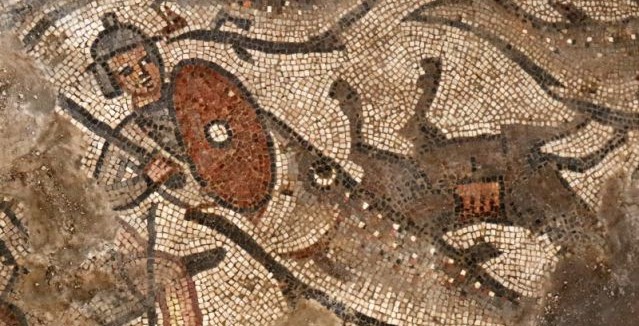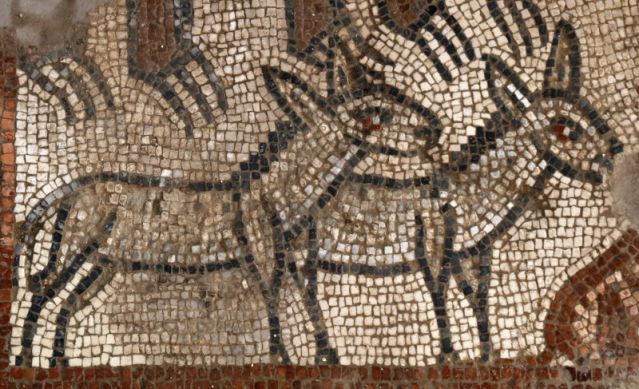A set of mosaics depicting two scenes from the Hebrew Bible has been discovered by archaeologists carrying out excavations at a fifth century synagogue in Israel’s Galilee, the University of North Carolina at Chapel Hill announced this week.
“This is by far the most extensive series of biblical stories ever found decorating the mosaic floor of an ancient synagogue,” said UNC-Chapel Hill Prof. Jodi Magness, who led the excavations along with assistant director Shua Kisilevitz of the Israel Antiquities Authority. “The arrangement of the mosaics in panels on the floor brings to mind the synagogue at Dura Europos in Syria, where an array of biblical stories is painted in panels on the walls.”
The panels on the floor of the synagogue’s nave, the central part of the structure’s hall, illustrate two biblical stories: Noah’s Ark and the parting of the Red Sea. The panel centering on the former scene depicts an ark and pairs of various animals, while the latter shows large fish swallowing Pharaoh’s soldiers among overturned chariots.
“These scenes are very rare in ancient synagogues,” Magness added. “The only other examples that have been found are at Gerasa/Jerash in Jordan and Mopsuestia/Misis in Turkey [Noah’s Ark], and at Khirbet Wadi Hamam in Israel and Dura Europos in Syria [the parting of the Red Sea].”
Mosaics were previously discovered at the site in 2012, and excavations have been ongoing since. In 2012, Magness’s team excavated a mosaic showing Samson lighting the Philistine’s fields on fire with flaming foxes (as told in the Bible’s Judges 15:4) in the synagogue’s east aisle. The following summer, the team found a mosaic depicting Samson shouldering the gate of Gaza (Judges 16:3). A mosaic uncovered in 2013 and 2014 portrays the first non-biblical scene found in an ancient synagogue, thought to be the legendary meeting between Alexander the Great and the Jewish high priest Jaddua in Jerusalem. A panel found in 2015 besides this scene features a Hebrew inscription surrounded by figures of humans, animals, and mythological creatures including cupids.
A number of other recent archaeological finds have also shed light on ancient Jewish life in Jerusalem and the surrounding area.
A study published in April analyzed roughly 100 written messages found on pottery shards near the Dead Sea and determined that more people were able to read and write Hebrew during the First Temple period (around 600 BCE) than was previously believed.
In March, two seals bearing Hebrew names were unearthed in the remains of a building from the First Temple period in Jerusalem. The finding was particularly noteworthy as one of the names — Elihana bat Gael — was of a woman. “Seals that belonged to women represent just a very small proportion of all the seals that have been discovered to date. This is because of the generally inferior economic status of women, apart from extraordinary instances such as this,” Prof. Hagai Misgav of the Hebrew University of Jerusalem explained at the time.
The discovery in 2013 of artifacts showing a Jewish connection to Jerusalem going back 2,500 years prompted Prime Minister Benjamin Netanyahu to call the finds “historic testimony, of the highest order, to the Jewish People’s link to Jerusalem, to its land and to its heritage.”
In 1999, while expanding the al-Aqsa mosque, the Jerusalem Islamic Waqf — the religious authority in charge of governing the Temple Mount — dug and removed roughly 400 truckloads of topsoil from the complex, which was then dumped in a landfill at Jerusalem’s Kidron Valley under the cover of night. Israeli archaeologists, who were able to retrieve most but not all of the soil, consequently began to sift it in an effort to recover some ancient artifacts. Among the relics found are thousands of coins from the Second Temple period and the imprint of an ancient Jewish seal.
In 2007, the Waqf used a tractor to dig a 4-foot-deep trench on the northern end of the Temple Mount, allegedly to replace old electric cables. At the time, archaeologist Zachi Zweig said “there is a high probability that ancient remnants were damaged,” among them the foundation of a wall that could have belonged to the Second Temple. That incident led to the formation of the Israeli Committee for the Prevention of Destruction of Antiquities on the Temple Mount, which aims to prevent further damage to ancient artifacts by ongoing renovations at the site.
In Discovering Jewish History on the Golan Heights, featured in the May 2014 issue of The Tower Magazine, Stephen Rubin wrote of another archaeological treasure, Umm el Kanatir, and what it tells of Jewish life in the area nearly 1,300 years ago.
[Photo: UNC – Chapel Hill]





